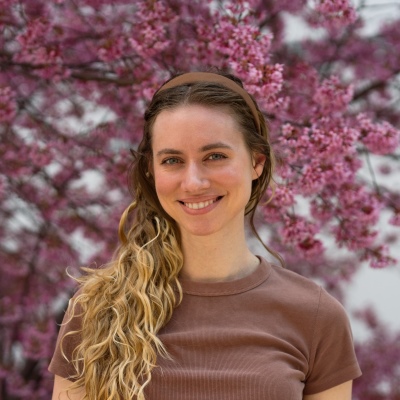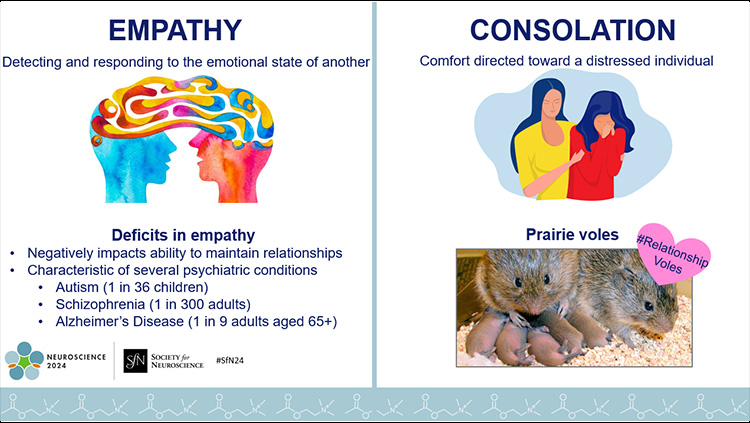Future of Neuroscience: Emilya Ventriglia

Emilya Ventriglia
“Future of Neuroscience” is a series of interviews with rising members of the field. A forward-looking complement to SfN’s “History of Neuroscience” autobiographies of distinguished researchers, interviewees reflect on their emerging careers and share thoughts on where they believe neuroscience is headed.
Emilya Ventriglia is a neuroscience PhD student at Brown University and the president of UAW 2750 at NIH, where she represents 5,000 early career researchers across the country. Ventriglia focuses on easing mental suffering through scientific discovery and collective action. Her research investigates the role of opioids in perception and mental illness. Ventriglia has built a deep focus in this area, beginning with studies of opioid-induced hyperalgesia during her master’s, followed by post-master’s work on opioid abuse liability, and now in her doctoral research on how opioids interact with stress and conflict.
Ventriglia organizes with thousands of NIH fellows in one of the largest union campaigns among federal researchers in over a decade, pushing for fair pay, enforceable rights, and a voice in shaping the future of science. She believes a just and sustainable research enterprise begins with treating scientists and students with respect and dignity.
Neuroscience Quarterly (NQ): What made you want to pursue a career in neuroscience?
Emilya Ventriglia (EV): When I was growing up in Oklahoma, the state had some of the highest rates of mental illness and substance abuse; opioids and illicit drugs were a huge issue. At the same time, it was ranked one of the lowest nationally for access to mental health care. Those statistics reflect a real crisis that I saw close up through the struggles of my loved ones and my community. It led me to want to study neuroscience to understand the brain and what people were going through. I wanted to know what I could do to address this.
It was my own kind of Steinbeckian journey, from Oklahoma to California, with no money and no roadmap — just a drive to find meaning.
I went to undergrad at the University of California, San Diego. It was my own kind of Steinbeckian journey, from Oklahoma to California, with no money and no roadmap — just a drive to find meaning. I grew up on food stamps and Social Security in Oklahoma. I was a first-generation college student. I had no guidance or connections, and I really didn't even know anything about higher education. I just knew that I wanted to understand the brain.
NQ: What is your area of research and what drew you to it?
EV: I study the endogenous opioid system and how it shapes everything from motivation to decision making. My research began with a focus on drug abuse, and now I'm investigating how opioids influence effective decision making, specifically through the medial prefrontal cortex. For many people with disorders like major depression, the treatment options are really slow. It takes weeks or months of uncertainty to see if a medication works. Meanwhile, you risk worsening symptoms, suicidal thoughts, or suicide, which is the second leading cause of death among young people. I was drawn to this field by this lack of hope I saw for people like me and those around me.
My research explores rapid-acting antidepressants such as ketamine, and I want to develop safer, more effective treatments that are rapid for depression. I use patch clamp electrophysiology to investigate how ketamine may interact not only with NMDA receptors but opioid receptors in the medial prefrontal cortex to produce its prolonged antidepressant effects. I also use in vivo two-photon imaging to study the role of the opioid system in the prefrontal cortex during chronic stress, examining how the system influences effective motivations in behavioral tasks like the platform-mediated avoidance task.
NQ: You’re a member of NIH Fellows United, a union representing scientists working at NIH on a nonpermanent basis. Your union negotiations led to increased pay and other benefits for these researchers. What motivated you to organize around workers’ rights?
EV: Access to research careers isn't equitable without action. As a first-generation low-income student, I've experienced firsthand the structural barriers that push talented scientists out of academia. I barely felt like I was able to stay in academia, and it was only through community support that I was able to continue. Our union organizing wasn't just about improving pay — it was also about making research careers more sustainable.
Scientists shouldn't have to sacrifice financial security or their health or stability to do this work. Science careers are not for the privileged, and we need wide-ranging perspectives to inform the science and how it's communicated so that it reaches the whole population, not just a subset. Through unionizing and winning a strong contract, we won better pay and benefits as well as enforceable protections for bullying, for harassment, discrimination — systemic issues that are common in the traditional hierarchical nature of science. We won some better protections for scientists who are on visas. These collective actions can reshape academia into something that's more inclusive and fair not only for us but the next generation.
NQ: What did you learn as a result of these negotiations about yourself, about unionizing, about the business of science?
EV: One thing I learned both before and during negotiations was that science is shaped by the conditions under which it happens. And if we want a research system that is going to actually serve our society, science that actually impacts people's day-to-day lives, then we have to fight for the people doing the research as well. While forming our union and during the negotiation of our contract, I saw the power that we have when we organize together. I saw how institutions can change when the people within them speak up. I also learned that organizing isn't just about policy or a contract, it's about building those relationships with peers. For example, I’ve talked to hundreds, if not thousands of coworkers at NIH and dozens of other labor unions, the purpose of which was to build confidence in a shared vision for what's possible when we act together.
I saw how institutions can change when the people within them speak up.
NQ: How are you and your team navigating the new environment at NIH?
EV: Since January 20, the work our union members do as early career researchers at NIH has become increasingly precarious. We’ve seen colleagues, supervisors, safety staff, and members of our union terminated. Routine purchases for basic supplies are delayed, hiring is stalled, and research is being interrupted because the people we rely on are gone.
Because NIH cuts are impacting universities and research hospitals nationwide, many of our members don’t know if they’ll be able to continue in science at all. Many are looking to leave the country and others are forced to abandon projects early. It’s a loss not just for us as researchers but for the public. Promising treatments for cancer, heart disease, and rare disorders are being abandoned midstream. The American public is paying the price.
As union members, we’re responding to these new policies by organizing scientists, educators, healthcare workers, and the public to take collective action. Through public campaigns, rallies, teach-ins, and contacting our elected representatives, we’re putting direct pressure on decision-makers. We’re shifting our priorities to make sure our voices are heard in Congress. That means sharing our stories and our science in accessible ways, fighting for funding, and building power together to defend the future of science and the public good it serves.























